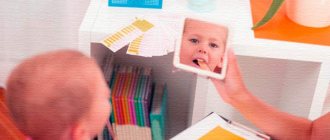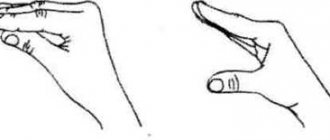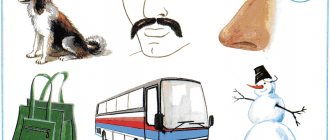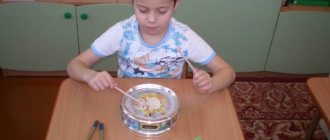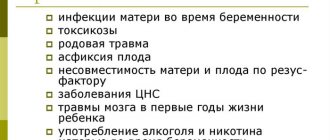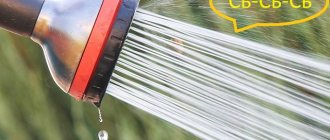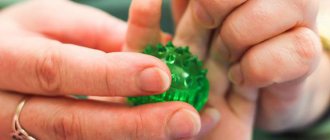Examination of sound pronunciation in preschool children
Natalia Obraztsova
Examination of sound pronunciation in preschool children
The formation of sound pronunciation usually ends by the age of five, five and a half years. By this age, the child must pronounce all the sounds of his native language correctly, that is, use them correctly in his own speech and not mix them with each other.
The simplest way to examine sound pronunciation is this : the child is shown pictures and asked to name them. In words, the sound should be in different positions: at the beginning, in the middle and at the end of the word. Then they ask the child to come up with a short phrase with this word. If it’s difficult for him, they help him. If it was not possible to find the necessary pictures, then simply ask the child to repeat the words with different sounds .
The most common speech defects in preschool children are sound pronunciation disorders . Usually the following groups of sounds are violated: whistling (s, s', z, z', ts, hissing (sh, zh, h, sch, sonorant (l, l', p, r,, j, back-lingual (k, k' , g, g', x, x', voiced (c, h, g, b, d, g, soft (t,, d,, n,)
.
In some children, only one group of sounds , for example, only hissing sounds or only back-lingual ones. Such a violation of sound pronunciation is defined as simple (partial, or monomorphic. In other children of sounds are disturbed simultaneously , for example, hissing and back-lingual or whistling, sonorant and voiced. Such a violation of sound pronunciation is defined as complex (diffuse, or polymorphic.
In any of the above groups, three forms of sound :
- distorted pronunciation of sound .
- absence of sound in the child’s speech , i.e. inability to pronounce it
- replacement of one sound with another available in the phonetic system of a given language.
Violations of sound are designated by terms derived from the names of Greek letters corresponding to the basic sound of each group :
- phonetic disorders of whistling and hissing sounds are called sigmatisms, and phonemic disorders - parasigmatisms - from the name of the Greek letter sigma, denoting the sound s ;
- phonetic violations of the sounds l and l' are called lambdacisms, and phonemic violations - paralambdacisms - from the name of the Greek letter lambda, denoting the sound l ;
- phonetic violations of the sounds p and p' are called rhotacisms, and phonemic violations - pararotacisms - from the name of the Greek letter rho, denoting the sound p ;
- phonetic violations of the sound j are called iotacisms, and phonemic ones - paraiotacisms - from the name of the Greek letter iota, denoting the sound ;
- phonemic - parakappacisms - from the name of the Greek letter kappa, denoting sound to phonetic disorders of back-lingual sounds are called kappacisms.
Disorders of groups of voiced and soft sounds do not have special terms - they are called:
- voicing defects;
— softening defects.
To determine the nature of the violation of a particular group of sounds (whistling, hissing, etc.), you need to clearly know these varieties, and also develop the skills and abilities necessary for examining sound pronunciation :
the ability to listen, that is, to isolate defective sound from the speech stream and determine how it is disturbed;
the ability to record the work of the organs of the articulatory apparatus when pronouncing a disturbed sound : to see which movements do not work, what participation the lips, lower jaw, and each part of the left and right half of the tongue take;
skills and abilities to communicate with children suffering from speech disorders (the ability to call a child for a conversation, during which the pronunciation of sounds in the speech stream , in individual words, and when pronounced in isolation) is checked.
It is advisable to adhere to a certain check procedure so as not to miss anything and to collect the necessary material, on the basis of which it will be possible to draw up a work plan to correct the child’s sound pronunciation .
When conducting an individual examination , the speech therapist records all the children's in a speech card indicating the date of the examination . In each child’s individual notebook, one or two pages are allocated to describe the results of the examination . There, the teacher notes the presence of gross, visible defects in the structure of the articulatory apparatus, then records the state of sound pronunciation
Let's take a closer look at the procedure for examining sound pronunciation :
1) Examination of speech sounds in children begins with a thorough check of isolated pronunciation. The following groups of sounds :
- vowels A, O, U, E, I, Y;
- whistling, hissing, affricates (С, Сь, З, Зь, Ц, Ш, Ш, Шch)
;
- sonorant sounds (P, Rb, L, L, M, мь, Н, Нь)
;
- voiceless and voiced pairs (P-B, T-D, K-G, F-V)
in hard and soft sounds
(P-B, T-D, K-G, F-V)
;
- soft sounds in combination with different vowels, i.e. PI, PYA, PE, PYU (also Дь, Мь, Ть, Сь)
.
During the examination, it is necessary to note the nature of the child’s pronunciation of isolated sounds , indicating the nature of the violation (for example, S-Sh (replacement)
; WHAT, etc.
Tasks consisting of repeated repetition of one sound , since this creates conditions that facilitate articular switching from one sound to another .
Also useful for speech therapy analysis is repetition of two sounds or syllables , which implies a clear articulatory switching (for example, KAP-PAK)
.
First, sounds that differ sharply from each other in articulation are presented, then closer ones.
At the same time, there are cases when children do not succeed in motor switching from one sound to another and, instead of repeating the initial sound of the second pair, they perseverate the previous one. The appearance of an “averaged”
articulations (for example, T and D are conveyed by the same semi-voiced ones, T and Ть are semi-soft).
2) Then the speech therapist finds out how the child uses sounds in speech . When checking, attention is paid to substitutions, distortions, confusions, and omissions of sounds . For this purpose, the pronunciation of words is examined . Sets of pictures are presented, including words from the sounds . Words of different syllabic structures are selected. Particular attention is paid to how these sounds are pronounced in sentences.
3) The ability to pronounce sounds in sentences consisting of correctly pronounced sounds and defective ones .
sound defects are grouped according to phonetic classification.
Games and gaming techniques for examining sound pronunciation in children :
1. “Magic cap”. On the playing field there are “holes” where pictures are drawn, the names of which contain the sound . The magic cap falls into one of the holes. The child names the corresponding picture.
2. "Helicopter". The round dial is divided into several sectors. In each of them a corresponding picture is drawn, in the middle of the dial there is an arrow. The child, moving the arrow, stops it at any picture, calling it.
3. “The Cheerful Fisherman.” The box contains pictures, the names of which contain the sound . The child uses a fishing rod to “catch” pictures and name them.
4. “Who is the most attentive?” There are envelopes on the table, each of them contains a part of a cut picture. The child takes out individual parts, looks for the missing elements, puts them together and names the picture.
5. “Magic chamomile.” On each petal of the chamomile there are pictures with the sound . The child, “opening” the petals, names the corresponding pictures.
6. “Mysterious chest.” The beautifully decorated chest contains toys whose names include the sound . The child takes the toy by touch, guesses it and names it.
7. “Let’s decorate our Christmas tree.” A small artificial Christmas tree is placed on the table. The child, at the request of the speech therapist, hangs pictures of toys on it and names them.
8. Game “On the contrary”. The speech therapist throws a ball to the child, names a forward syllable with a given sound , and the child, returning the ball, names a reverse syllable with the same sound .
9. “Find your match.” Pictures depicting one or more identical objects are laid out on the table; children take any picture they like, then, at the speech therapist’s signal, they split into pairs so that one child has pictures with one object, and the other has two or three. Then each of the children names their picture.
10. “Collect an autumn bouquet.” In the group there is a “tree growing”, on which the outlines of autumn leaves are attached. On their reverse side there are pictures with the sound being examined . Children walk around the group and listen to music. As soon as the music stops, the speech therapist says: “The leaves are falling, flying, leaf fall is coming.” Children quickly take the leaves and approach the speech therapist. Then everyone names the picture drawn on their piece of paper. The leaves are placed in a vase.
BIBLIOGRAPHY
1. M. F. Fomicheva. Raising children correct pronunciation, - M., -1999.
2. L. N. Efimenokova. Formation of speech in preschool children . - M., 1995.
3. E. I. Negnevitskaya, A. M. Shakhnarovich. Fundamentals of the theory and practice of speech therapy. – M., 1998
4. Basics of speech therapy with a workshop on sound pronunciation : Textbook. aid for students avg. ped. schools, institutions / M. F. Fomicheva, T. V. Volosovets, E. N. Kutepova, etc.; Ed. T.V. Volosovets - M.: Publishing House
, 2002. - 200 p.
5. Gribova, O. E. Technologies for organizing speech therapy examination : methodological manual / O. E. Gribova. - M.: Iris-press, 2005. - 96 p.
6. Nishcheva N.V. System of correctional work in a speech therapy group for children with general speech underdevelopment. – St. Petersburg, 2005.
Worry, panic ahead of time
For example, when a child is 1.5-2.5 years old and he cannot pronounce certain sounds, he should consult a doctor. Especially if this applies to difficult consonances Ш, Л, Р. And with such a problem, parents immediately run to a sound pronunciation examination. But these sounds are complex, and a young child is simply not able to pronounce them correctly due to his age. That is why he can either skip them or replace them with simpler letters that he can speak correctly.
Also, up to a certain age, this is also a physiological feature, let’s say, a conditional norm. This topic is covered in the most detail in Konovalenko’s book “Express examination of sound pronunciation.”
What to pay attention to
When assessing auditory attention, parents should keep a sound pronunciation test protocol. This can be done in any notebook or notepad. This action is necessary not only to try to remember and forget over time, but to have accurate information about all errors in the perception of what was heard.
Perhaps the child incorrectly indicates which instrument sounded, or did not recognize the direction of the bell. All this must be recorded in the pronunciation examination protocol. Firstly, this will make it easier for the adults themselves; they will understand what to pay attention to. And secondly, if you need to contact specialists, the notebook will be an excellent assistant for correcting the situation.
Distorted pronunciation
Throat sounds R are when the baby vibrates not with the tip of the tongue, but with the palate, that is, the result is a more French manner, or when the child, when pronouncing hissing and whistling sounds, sticks his tongue between the teeth - all this can no longer be called age-related tongue-tiedness.
In this case, at 4-4.5 years it is necessary to contact a speech therapist, because such defects cannot be corrected on their own. Here you should not expect the sound to come on its own. The longer you wait, the stronger this defect becomes fixed and then it becomes more difficult to correct the situation.
How to evaluate the result
Again, it is very important to record each step in a speech therapy album to examine sound pronunciation. And even more so, when parents check speech or simply play with a child and realize that a syllable or word is reproduced poorly, this needs to be recorded. If a defect has been discovered, that is, the baby does not succeed in everything or something, then it is necessary to make an entry in the album to examine sound pronunciation.
It happens that a child completely lacks a sound, for example, “uk” instead of “bow” or “eka” instead of “river”, or the letter is replaced by a simpler one, for example, instead of “ball” he says “sarik”. And if we are talking about the fact that the child is under 4–5 years old, then in fact such a defect may be a simple age-related tongue-tiedness, that is, a feature due to the fact that the baby is not yet physiologically able to pronounce the sound correctly. There is a high probability that the problem will resolve itself when the child grows a little and develops his articular muscles. It is worth remembering that each sound must become at a certain age, when the speech apparatus and hearing mature.
But still, ideally, parents should simultaneously create favorable conditions. It is necessary to conduct games and various training sessions for the development of hearing, articulatory gymnastics, and so on. This is necessary so that the sound appears on time and no problems arise.
Sometimes it can happen that even when the mother plays various games, the child’s sound does not get into the right place and it is necessary to contact a specialist. But if adults have prepared a certain base, and the baby already knows many tasks for examining sound pronunciation, it will be easier for the speech therapist, since speech hearing is developed and the apparatus is strengthened.
The mistake of many is that parents wait for a certain age. This is wrong, as soon as the child begins to understand what is being said to him and learns to repeat after his parents, educational games can be played 1-2 times a week.
If such deviations are observed in a child after 4–5 years, then the delay indicates that there is some reason that prevents the child from learning a particular sound. And this is a true disorder, and in difficult situations it can even be a problem of a neurological nature, when the connection between the organs of articulation and the central nervous system is disrupted. In such a situation, each training session should be carried out only under the guidance of a specialist.
The second point is to develop speech and non-speech hearing
Why is this necessary? In order for a child to correctly pronounce certain sounds, he must first hear them correctly. That is, he must have normal physiological hearing, he must correctly perceive both non-speech and speech sounds. And there is also a nuance here. Even if a child has naturally good, acute physiological hearing, this does not guarantee that everything will be all right. This happens because it is so inherent in nature. The pronunciation of sounds is initially imperfect and you need to help the child develop them and pronounce them correctly. And this is within the power of every parent.
Non-speech sounds are all the sounds of the surrounding world except speech itself. For example, this is the roar of the wind, the crackling of snow, raindrops, and so on.
Speech hearing is the ability to distinguish where one word ends and another begins, to determine tempo, intonation, that is, all the subtleties of speech. To further understand the topic, you can read Konovalenko’s works “Survey of Sound Pronunciation.”
Articulation gymnastics
Up to four years of age, it is recommended to do such training at least several times a day, that is, it is not necessary, but it is desirable. You can use at least the simplest exercises; it is not necessary to immediately take on the entire complex of articulatory gymnastics.
You can start doing it from the age of one, and sometimes earlier. For example, you can use the following exercises: invite the child to make a face, show his tongue and hide it, puff out his cheeks and retract them, make his lips a bow, and much more. All these tasks are quite accessible to the child and help strengthen his speech muscles: lips, cheeks and tongue. This complex helps the baby pronounce certain sounds. In adulthood, if you do such gymnastics, it will be easier for him to position these organs correctly.
And with these three points, including knowledge of norms, development of skills and gymnastics, parents help the child when he still physiologically does not say anything. Adults create favorable conditions for the correct production of sounds.
Know age norms
Knowledge will help you not to panic ahead of time. That is, there are age periods when certain sounds are simply physiologically quite difficult for a child. He is unable to pronounce them. When parents know this, they stop panicking because they understand that it is just an age factor.
And vice versa, if adults understand that the sound should have appeared according to the norms, but the child does not have it or replaces it with another one in speech. Then parents understand that there is no need to waste time, but to do something as soon as possible, get a consultation, undergo a sound pronunciation examination and begin to help the child in a playful way so that the sound finally appears and fits correctly.
Therefore, knowing age norms is very, very important.
Toy location
In addition to the fact that the child must determine what object sounded, it is very important that he knows where the sound comes from. And here you can invite the baby to turn away, ringing the bell behind him from below, above, right, left, that is, in different positions. And he must point with his finger or say where he hears the sound from.
An important point in the method of examining sound pronunciation is closing the child’s eyes. Before doing this, you must definitely ask his permission. There are different options for reproducing this action: firstly, one of the adults can close their eyes with their own hands, and secondly, you can tie it with a small scarf. But in any case, the child should not be afraid and protest, and to do this, you first need to ask about his desires.
The important idea of this point is that the method of examining sound pronunciation involves testing auditory understanding. If the child is not yet confident enough in performing these tasks, does not understand what is required of him, or makes mistakes, then it is important for adults to not check and forget once, but to conduct regular training.
Attention check
Before parents begin directly to those games, topics and exercises that are needed for correct sound production, it is necessary to evaluate their hearing. Therefore, it all starts with a qualitative check of the child’s attention.
This can be done in several ways. Ideally, do them all. Not at one time, of course, not in one day, but still try to complete the exercises. The most important thing is for both parents and child to tune in. It is important that the baby wants to play so that he is in a good mood. Once again, it is worth noting that it is absolutely not necessary to do everything at once and in one day.
The most important thing is that it is fun for the child and does not depress the parents themselves.
Sounding toys should be placed near the child.
The essence of the exercise is that you need to close the child’s eyes or ask him to turn away, in general, do what makes him comfortable. And after that, you need to take material for examining sound pronunciation, in this case it’s a toy, and start sounding it. Then the baby turns, looks at all his treasures and shows the instrument the adult played.
Naturally, you shouldn’t take completely new toys to play. The child should already know what the objects used sound like. If this point is not fulfilled, then first you need to play with the baby so that he learns and remembers what this or that toy sounds like. In this case, you need to pay the child’s attention to every sound.
